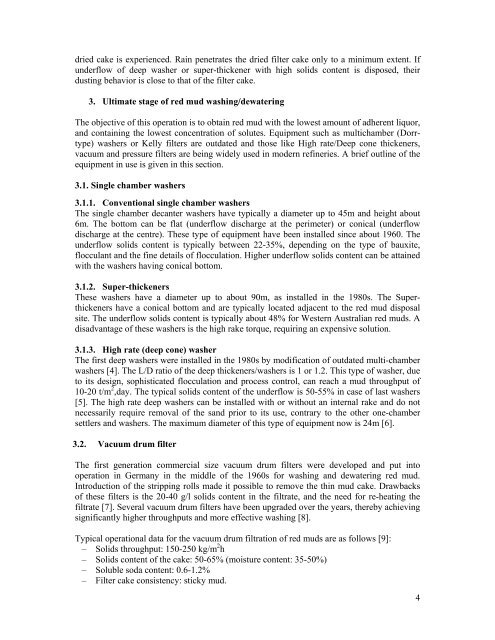De-watering, disposal and utilization of red mud: state ... - Redmud.org
De-watering, disposal and utilization of red mud: state ... - Redmud.org
De-watering, disposal and utilization of red mud: state ... - Redmud.org
You also want an ePaper? Increase the reach of your titles
YUMPU automatically turns print PDFs into web optimized ePapers that Google loves.
dried cake is experienced. Rain penetrates the dried filter cake only to a minimum extent. If<br />
underflow <strong>of</strong> deep washer or super-thickener with high solids content is disposed, their<br />
dusting behavior is close to that <strong>of</strong> the filter cake.<br />
3. Ultimate stage <strong>of</strong> <strong>red</strong> <strong>mud</strong> washing/de<strong>watering</strong><br />
The objective <strong>of</strong> this operation is to obtain <strong>red</strong> <strong>mud</strong> with the lowest amount <strong>of</strong> adherent liquor,<br />
<strong>and</strong> containing the lowest concentration <strong>of</strong> solutes. Equipment such as multichamber (Dorrtype)<br />
washers or Kelly filters are outdated <strong>and</strong> those like High rate/<strong>De</strong>ep cone thickeners,<br />
vacuum <strong>and</strong> pressure filters are being widely used in modern refineries. A brief outline <strong>of</strong> the<br />
equipment in use is given in this section.<br />
3.1. Single chamber washers<br />
3.1.1. Conventional single chamber washers<br />
The single chamber decanter washers have typically a diameter up to 45m <strong>and</strong> height about<br />
6m. The bottom can be flat (underflow discharge at the perimeter) or conical (underflow<br />
discharge at the centre). These type <strong>of</strong> equipment have been installed since about 1960. The<br />
underflow solids content is typically between 22-35%, depending on the type <strong>of</strong> bauxite,<br />
flocculant <strong>and</strong> the fine details <strong>of</strong> flocculation. Higher underflow solids content can be attained<br />
with the washers having conical bottom.<br />
3.1.2. Super-thickeners<br />
These washers have a diameter up to about 90m, as installed in the 1980s. The Superthickeners<br />
have a conical bottom <strong>and</strong> are typically located adjacent to the <strong>red</strong> <strong>mud</strong> <strong>disposal</strong><br />
site. The underflow solids content is typically about 48% for Western Australian <strong>red</strong> <strong>mud</strong>s. A<br />
disadvantage <strong>of</strong> these washers is the high rake torque, requiring an expensive solution.<br />
3.1.3. High rate (deep cone) washer<br />
The first deep washers were installed in the 1980s by modification <strong>of</strong> outdated multi-chamber<br />
washers [4]. The L/D ratio <strong>of</strong> the deep thickeners/washers is 1 or 1.2. This type <strong>of</strong> washer, due<br />
to its design, sophisticated flocculation <strong>and</strong> process control, can reach a <strong>mud</strong> throughput <strong>of</strong><br />
10-20 t/m 2 ,day. The typical solids content <strong>of</strong> the underflow is 50-55% in case <strong>of</strong> last washers<br />
[5]. The high rate deep washers can be installed with or without an internal rake <strong>and</strong> do not<br />
necessarily require removal <strong>of</strong> the s<strong>and</strong> prior to its use, contrary to the other one-chamber<br />
settlers <strong>and</strong> washers. The maximum diameter <strong>of</strong> this type <strong>of</strong> equipment now is 24m [6].<br />
3.2. Vacuum drum filter<br />
The first generation commercial size vacuum drum filters were developed <strong>and</strong> put into<br />
operation in Germany in the middle <strong>of</strong> the 1960s for washing <strong>and</strong> de<strong>watering</strong> <strong>red</strong> <strong>mud</strong>.<br />
Introduction <strong>of</strong> the stripping rolls made it possible to remove the thin <strong>mud</strong> cake. Drawbacks<br />
<strong>of</strong> these filters is the 20-40 g/l solids content in the filtrate, <strong>and</strong> the need for re-heating the<br />
filtrate [7]. Several vacuum drum filters have been upgraded over the years, thereby achieving<br />
significantly higher throughputs <strong>and</strong> more effective washing [8].<br />
Typical operational data for the vacuum drum filtration <strong>of</strong> <strong>red</strong> <strong>mud</strong>s are as follows [9]:<br />
– Solids throughput: 150-250 kg/m 2 h<br />
– Solids content <strong>of</strong> the cake: 50-65% (moisture content: 35-50%)<br />
– Soluble soda content: 0.6-1.2%<br />
– Filter cake consistency: sticky <strong>mud</strong>.<br />
4


